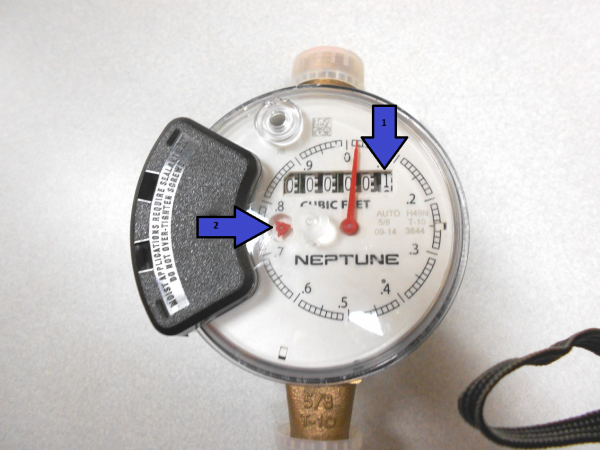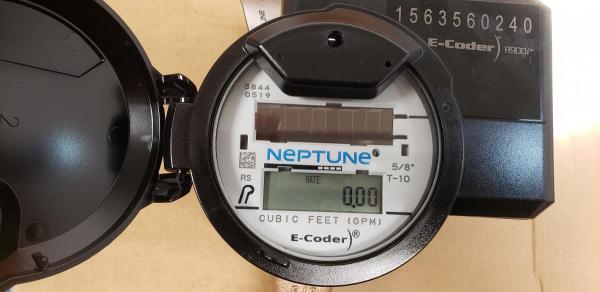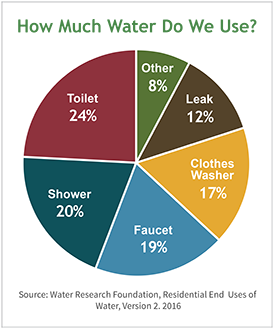How Can I Detect a Leak?
The below is copied, in part, from the March 2016 Village Newsletter.
Most residents in the Village receive their water from the Village’s water supply. Bills for water use are sent quarterly, each covering a three month period. Bills are based on household consumption, administrative costs, and infrastructure improvements. Consumption represents the largest portion of the bill. Village water rates are divided into 6 tiers with the most residents in Tier 2 and Tier 3 ranging from 901 to 1 million cubic feet/year.
How to monitor your water consumption:
Every water customer has a water meter which records their water usage. By looking at your meter you can find out several things about your water consumption and also detect possible leaks.


The water meter in the first picture is the older model. It is set at 1 (see “1” arrow). As water is used, the number goes up. Each increase of ‘1’ equates to a cubic foot of water (7.48 gallons). By keeping track of the change in this number from day to day or at regular intervals, you can monitor your water usage. If your water usage seems to be increasing at a rate which seems too fast, you may have a leak.
The water meter in the second picture is the newer model that the department is installing as the older meters malfunction or reach end-of-life. This meter shows a flow rate of 0.00, which would indicate no water is being used. In order to have the readings displayed, the homeowner would need to have ample light in the room or shine a flashlight on the solar panel above where the face says Neptune.
Your water meter can also indicate if you have a leak. Arrow “2” in the picture points to a red triangle which spins when water is running. If you turn off all the water in your house, and the red triangle is still spinning, you probably have a leak.
According to John Spatta, Croton’s Water Foreman, most residential leaks come from running toilets. Other common sources are dripping faucets, hose connections and underground sprinkler systems. If you perform this test and detect a leak, a plumber may be needed to pinpoint it and repair it.
What contributes most to my water consumption?
When assessing your water bill, keep in mind that your usage may be quite different from your neighbors. The number of people in a household as well as the number of people in the house during the day, number of loads of laundry on a daily/weekly basis, showering vs. bathing in a tub, irrigation of lawns or garden watering, top filling pools, etc. all affect your consumption.
According to the EPA, the bathroom is where most water inside is consumed. For example, an older toilet may use up to 7 gallons/flush while new ones are generally 1.6 gallons/flush. At 7 flushes/person/day, a family of four with an older toilet might consume 196 gallons/day or 71,540 gallons/year (9564 CF/year). At the Tier 2 billing level, $8.69/100CF, this amounts to $831.11 per year.
There are many heavy water users in each household, washing machines, showers, faucets and hoses. In older homes, upgrading these with “low-flow” shower or faucet heads and water conserving appliance models can reduce water consumption. Toilet leaks, faucet drips, underground irrigation leaks, and poor hose connections are the stealthy users of water which may not be immediately obvious. The amount of water from these leaks can add up quickly. The EPA estimates that a running toilet can use up to 200 gallons/day.
Pressure-reducers can also affect water usage. The majority of houses have a pressure-reducer which reduces their in-house pressure to an average of 55 psi from a much higher, and variable, street pressure. A malfunctioning pressure reducer can cause leaks or an increase in the amount of water coming out of faucets and water connections due to the higher pressure. The pressure-reducer can also be checked by your plumber.
The pie chart below from the United States Environmental Protection Agency (EPA) illustrates water usage in the average home.

The Village Water Dept. personnel are always available to review your individual circumstances with you if you have questions about your water bill. They can be reached at 862-1419 during business hours.

